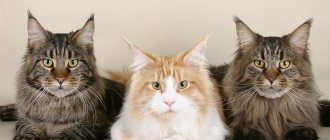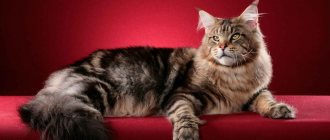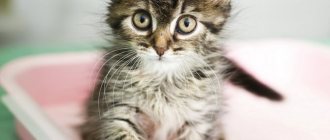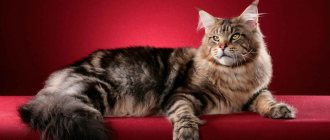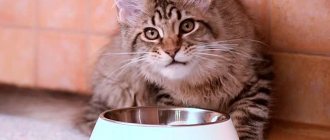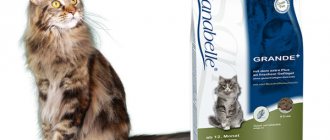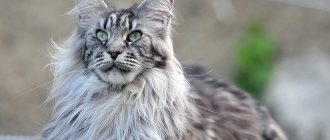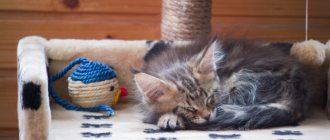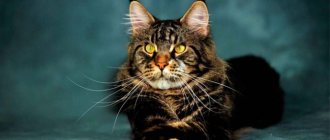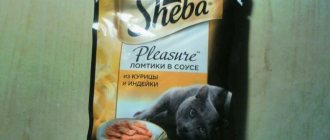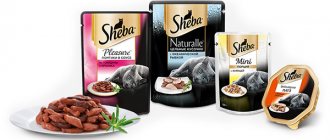Maine Coons are a breed of large giant cats. They have a huge, powerful body with long hair and a fluffy, magnificent tail. Muzzle, similar to a wild animal with a specific jaw structure. The characteristics of the breed require careful selection of the Maine Coon's nutritional structure, taking into account the health and age of the pet.
What do Maine Coons eat?
Large, even huge Maine Coons, despite their body weight, are very mobile, active animals. How much a Maine Coon eats cannot be mastered by another, ordinary cat. For a long and healthy life, they need not only plentiful, but also balanced food for energy supply and growth. The menu consists of: proteins up to 40%, fats up to 30%, carbohydrates up to 20% and more than 2% fiber.
To organize proper nutrition, use:
- Ready-made food (dry, wet), factory-made with premium quality and higher.
- Natural food, home-cooked using a variety of meat, dairy, vegetable, fish products, with vitamins and minerals.
To ensure good digestion and assimilation of the food you eat, when feeding you need to follow the recommendations of veterinarians:
- very carefully, if absolutely necessary, mix natural and industrial products in your diet:
- cold or too hot food has a harmful effect on housing and communal services, it is useful to warm it up slightly;
- to avoid poisoning, use only fresh, high-quality products;
- do not allow food to sit in bowls for a long time;
- feed your pet only in compliance with the diet according to the established schedule;
- provide constant, free access to clean water, preferably bottled.
Ready-made feed
For busy people who spend a lot of time at work or on the road, it is convenient to use ready-made food: dry, wet, which makes caring for a pet easier. They reduce the time spent preparing food for kuna to a minimum. Such food products have a long shelf life and are easy to use in the countryside and when traveling.
It is enough to choose a manufacturer that maintains a high rating of food for Maine Coons. Almost all finished products contain information about the composition and portion instructions for consumption for cats of different ages, from monthly kittens to mature individuals. Separately, complexes are produced for pregnant cats before and after childbirth, and for castrated cats. As a rule, factory products are provided with the necessary vitamins and microelements and it is desirable that they be adapted for Maine Coons.
For various breeds, including coons, the following lines of food have been developed by the following companies:
- Hills, Iams, a line of dry and wet food, produced in factories in the USA and the Netherlands
- Royal Canin, the oldest French company, founded in 1967, has a representative office in Russia.
- Mars, an American company, is a well-known manufacturer of various non-perishable products, including pet food.
- Ralston Purina, the oldest Italian company, celebrated 125 years since its opening.
- Diamond Pet Foods, manufacturer of Nutra Gold food in the United States.
- Midwestern Pet Food, the company's food production is packaged, in two US plants.
- Eagle Products, an American company produces pet products in Mishiwaka, Indiana.
Attention! Economy class food contains a large amount of grains and low quality meat products that are unsuitable for food with the use of flavor enhancers and dyes.
Wet food
Canned food in wet form, such as pates and jellies, is more expensive than dry food. It is better absorbed in the stomach and contains nutrients beneficial for cats. When purchasing canned food you need to consider:
- the shelf life is limited, it is indicated on the can;
- stock of canned food must be stored in the refrigerator;
- before feeding, be sure to heat the food to the optimal temperature, approximately 20 degrees;
- opened cans of food should not be stored longer than required according to the instructions;
- Food that is not eaten by the pet is not left in the bowl for a long time, it spoils.
Dry food
Dry food is produced in large quantities and varied in composition. There are many companies that produce nutritional granules, both for kittens of different ages and for adult cats, including sterilized and neutered cats. When switching to dry feeding, be sure to provide your pet with plenty of purified water in a large, stable container where he can rinse his paws if desired.
Features of the use of dry food when feeding coons are that:
- you can make large stocks, it has a long shelf life;
- dry complexes are cheaper than canned wet food;
- granules can be poured into a car feed container for a long time, when leaving home, even for a long period.
Advice! In the diet, it is more useful to combine dry and wet food in a ratio of one to four, using food from the same company, of the same class.
Mixed diet
Many owners prefer a mixed type of feeding. It's comfortable. Ready-made food can be kept “just in case,” and natural feeding can be used as a basis.
You can feed or supplement your pet with ready-made food if he wants to eat it.
You can also use dry food while traveling, where it is not possible to prepare food.
Natural nutrition
Many owners believe that it is correct to feed the Maine Coon homemade food. But any food from the human table will be harmful to the pet and even dangerous due to its content of fats, salts and seasonings.
Meat menu
Maines, who acquired carnivorous instincts on American farms, retained their meat tastes. For carnivores, meat products are the main dietary ingredients, accounting for more than 50% of the daily diet. It may include veal, beef, and a variety of game. Any boiled offal will be useful. Such as liver, heart, kidneys. Raw meat is well frozen before consumption by animals to prevent infection with worms.
Fish menu
Fish, as a source of fatty acids, is very useful for maines, but in limited quantities, no more than 2 times a week due to the threat of deposits in the kidneys. River fish is not recommended to be included in the diet; it contains many small bones and is often infected with helminths.
Dairy
Milk is good for kittens; it is easily digestible. For adult coons, it is better to use fermented milk products in their diet, but in small quantities up to 4 times a week. You can diversify your diet with kefir, natural yogurt, cottage cheese, sour cream; a piece of cheese or butter will be useful.
Porridge
Cereals of rice, buckwheat, oatmeal, millet, wheat contain a complex of minerals and fiber necessary to strengthen the body of large maines. Porridge is cooked from them in water and mixed with meat.
Vegetables and greens
The daily diet includes boiled or raw vegetables. Carrots, pumpkin, cabbage, and beets, rich in vitamins and microelements, are included in the menu, mixed with cereals and meat products. The variety of vegetables is chosen according to the pet’s liking. Don't forget to add greens to your cat's diet. Grass is specially grown for cats, as are sprouted cereals such as wheat and oats.
Attention! It is dangerous to bring grass from city streets; it can contain dangerous bacteria and germs.
Eggs
Eggs, especially their yolks, are a source of many vitamins. To avoid allergic reactions, include the yolks of any eggs in the Maine Coon's diet, mixing with cottage cheese, but not often, up to 2 times a week is enough. The quail egg does not need to be boiled and can be eaten together with protein.
Water
Water should be filtered, preferably bottled, in unlimited quantities. Pour fresh liquid into a large, stable container, in an area with constant accessibility, not far from the main food.
Supplements
For large Maine cats kept on homemade natural food, it is imperative to strengthen the bones and the whole body by including additional vitamin and mineral complexes:
- Cat-Mineral Tabs in the form of daily tablets;
- Beaphar, delicious and healthy vitamins from Holland;
- POLIDEX, a glucosamine supplement from the UK.
Attention! A vitamin complex for pets is chosen on the advice of a veterinarian, after examining the pet and a biochemical blood test.
Prohibited Products
When organizing a natural diet for Maine cats, it is imperative to exclude some harmful foods:
- Small river fish and chicken bones so that the cats do not damage their stomachs.
- Fatty raw meat carries a risk of acquiring worms.
- Potatoes are a starchy vegetable that causes diarrhea.
- Legumes are difficult for the stomach to digest.
- Smoked meats and pickles in any form cause harm to internal organs.
- Sweets and confectionery products lead to obesity.
Standards
They are determined by the felinological system adopted in the country. Popular: WCF, TICA, FIFe. In the Russian Federation, WCF is more often used.
| WCF | TICA | FIFe | |
| Body |
| large long body, rectangular in shape |
|
| paws of medium length |
|
| |
| the tail has long hair, its length reaches the shoulder | tail well furred | tail with flowing hair, long | |
| Head | massive skull | the forehead is rounded quite strongly | the forehead is softly rounded |
| high cheekbones | prominent cheekbones | ||
| massive box, square shape | box - square | muzzle - square | |
| massive chin | straight chin | strong chin | |
| the neck is of medium length | muscular neck | neck is strong | |
| Ears |
|
|
|
| Eyes |
|
|
|
| Wool |
|
|
|
| Color |
| any colors |
|
| Defects | coat of one length |
|
|
Cooking kunin porridge
The Maine Coon's diet often includes the popular so-called “kunya porridge”. Which contains up to 80% meat products, including offal and many other ingredients that create a balance of nutrients with vitamins and minerals. As an example, the following composition is often used:
Kunya porridge recipe
Chicken meat (options are possible) – 1 kg + offal (pork or chicken liver, heart) – 1 kg + boiled vegetables (according to pet’s preference) – 200 g + olive oil – 2 tbsp. spoons + kelp with cottage cheese – 100 gr.
Everything is mixed and fed in portions according to a schedule throughout the day.
Leonardo Quality Selection
Photo: https://beru.ru
The best premium food with natural ingredients. The basis of the diet is chicken meat and hearts, supplemented with zinc, phosphorus, manganese, vitamins E, D, A and B. The composition contains no preservatives or artificial flavors. And one jar is enough for even a large Maine Coon to last a whole day. A balanced diet is perfectly absorbed by the pet’s body and has a positive effect on its appearance.
Leonardo Quality Selection cat food
Advantages:
- reasonable price
- well digested
- efficiency
- versatility
- absence of harmful components
- a lot of meat in the composition
- pleasant aroma
Feeding neutered Maine Coons
The operation of castration of Maine Coons often leads to a narrowing of the urethra, which is a threat to the full passage of the urethra. Therefore, in the menu for the Maine Coon, they adhere to a diet throughout their lives and do not consume foods that cause salt deposits. First of all, this is a fish rich in phosphorus, calcium and magnesium. There is no need to feed your Maine Coon to gain weight, which is dangerous for obesity due to increased appetite after castration of the pet.
For operated cats, factory-made, ready-made food, balanced for castrated animals, is well suited.
Advice! Outdoor games with a coon will help your neutered pet stay fit after surgery.
Care and maintenance
The raccoon cat, or Maine Coon, requires special care. If we recall the description of its representatives, they have long hair, large sizes and a good appetite.
Maine Coon
Caring for a Maine Coon is not an easy task, so before you bring such a handsome dog into your home, you should think carefully about whether a person can devote a lot of time and effort to the animal.
This breed has a number of positive traits. These cats are smart, trainable, get along well even with small children, are clean and quickly adapt to the habits and behavior of their owner. The only drawback is the high maintenance requirements.
Basic conditions that must be met:
- Regular cleaning of the eyes from accumulated mucus. It appears even in a completely healthy animal;
- cleaning the ears. The area is quite delicate, so the procedure is carried out carefully so that the animal does not jerk and harm itself. Healthy and clean ears are pink in color, without foreign accumulations;
- the pet's long hair requires daily combing using a special comb;
- Claws should not be allowed to grow to too large a size. Otherwise, they will cause inconvenience to the pet.
Grooming
What to feed a kitten
During the first month, a newly born kitten is fed with the cat's mother's milk. Towards the end of the month it can already be fed. Typically, breeders start complementary feeding with ready-made feed. This is convenient, this premium class food is specially balanced for large breed kittens and takes into account all the growth characteristics of Maine Coons.
It is recommended to give preference to complexes consisting of all the components necessary for the growth of mains:
- Royal Canin Kitten Maine Coon, the main ingredient is chicken for Maine Coon kittens up to 15 months;
- Bosch Sanabell kitten, dry food with poultry for large kittens.
Considering that Maine kittens grow twice as fast as ordinary kittens, their daily food intake (complementary feeding) depends on the weight gained and is at least 10% of body weight. In this case, for each kilogram the digestibility of 60 kilocalories is calculated with the consumption of 10 g of proteins.
Start feeding a Maine Coon kitten at 2 months of age with regular food, taking into account the consumption of mother's milk in small quantities. The Maine Coon's diet gradually includes various types of meat and offal, and adds yolks, vegetables, herbs and dairy products.
After 3 months, the kitten moves to live in a new environment. When changing homes, he needs not only attention and affection, but gradual adaptation to the change in diet. When ready to feed, it is useful to keep the food from the previous manufacturer. When eating natural foods, they try to maintain the same list of products. The diet is also the same, 4-5 times a day.
Names and nicknames for Maine Coon
Diet from six months to a year
Up to one year old, Maine kittens grow and develop very quickly, they are entitled to food in large volumes and in calories. For normal development, it is recommended that they be given food in approximately the following amounts:
- Meat products, offal and fish -130 g;
- Vegetables with greens and herbs -40 g;
- Fermented milk products such as cottage cheese, kefir, sour cream -40 g;
- Porridge cooked in water from various cereals - 15 g;
- Vitamin complexes on the advice of a veterinarian.
Maine Coon colors
Diet from year
Cats continue to grow for a long time, up to 3-4 years, after which they acquire the shape, weight and size of an adult cat. The diet and feeding regimen do not change; there should be enough food for normal active life.
For an adult pet, a standard food set should contain:
- The protein component is at least 40% of the total volume;
- From fat components up to 30%;
- From heavy and light carbohydrates up to 25%;
- Fiber: at least 3%
Diet for older cats
Elderly cats with signs of developing diseases of the digestive tract need to consult a veterinarian on changing their diet and introducing special complex vitamins to support the body. Food should be less fatty and softer to chew, so meat products are ground into minced meat. When feeding ready-made food, choose products intended for older cats.
History of the origin of the breed
In the vastness of our country, a similar breed appeared quite recently, about 20 years ago or a little more. This happened when the well-known “Iron Curtain” fell and a mass of different, hitherto unknown breeds of cats and dogs headed towards us. The Maine Coon breed was no exception.
According to some information, the breed was first shown at an exhibition in Boston, after which the breed was forgotten for a long time, and undeservedly.
And yet, English farmers made a lot of efforts to preserve this amazing breed, which, in its breed characteristics, pointed to the American raccoon cat. Several decades ago, on the Isle of Man, which belongs to the English kingdom, a special coin was issued dedicated to the Maine Coon cat breed.
Feeding schedule
Diet, food quality, frequency and number of feedings per day are important for your pet’s health. Depending on the age of the maines and their physiological state, the feeding regime changes flexibly. The opinion that Maine Coons need to be fed according to their requirements is erroneous; animals do not always feel moderation in food, which leads to overeating and obesity, disturbances in the functioning of the heart, shortness of breath and constipation. A strict feeding schedule and dosed distribution of feed will help to avoid negative consequences.
Table: Mae-coon feeding schedule depending on age and physiological state:
The appearance of the Maine Coon, the condition of its shiny, well-groomed coat, the activity of its behavior, and its friendly character indicate the correct maintenance and chosen balanced feeding regime for the pet.
Care and maintenance
Maine Coon
Grooming
For a comfortable life, Manx cats need enough space. They love to run and jump, so they will likely feel cramped in a small space. Maine Coons also enjoy frolicking in the water, drinking from the tap and can relax in a sink or bathtub with drained water.
Before you bring your kitten home, prepare everything you need. Your pet will need bowls for food and water. You can't do without a tray. Install it in the bathroom or other room where the animal will always have free access.
